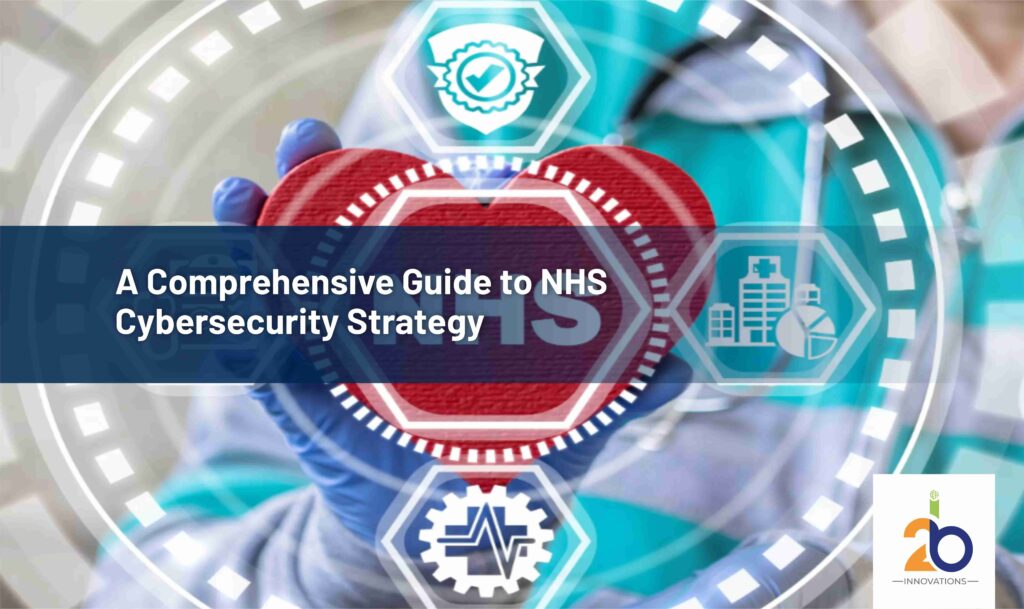
In the modern landscape of healthcare, both technology and data are important to help provide effective care to patients. However, as the healthcare sector is becoming increasingly digitized, organizations find it difficult to safeguard their medical devices, services, networks, and the information these devices and networks contain from cyber attacks. In England and on a global scale, various cyber incidents have occurred that have muddled patient care. These cyberattacks have led to safety risks and significant financial losses. According to the UK Department of Health and Social Care, the potential impact a cyber attack could have on this sector, both directly and indirectly, is huge, as it is estimated that daily, there are 950,00 general practice appointments, 45,000 major accident and emergency (A&E) department attendances, and 137,000 imaging event records. This is why the cybersecurity system in the United Kingdom has established a cybersecurity strategy to minimize cybersecurity risks so that they can protect patient, service user, and staff data and implement measures to quickly recover from cyber incidents if they occur.
What is the NHS Cyber Security Strategy?
The government of the UK has outlined a comprehensive plan to safeguard the National Health Service (NHS) from cyber attacks. This plan aims at promoting cyber resilience across the healthcare sector by 2030. This strategy has outlined 5 key ways that will help to build cyber resilience and protect the health functions and services that the nation depends on. To achieve national health security, organizations should be prepared for, protected from, and resilient in the face of cyber-attacks, considering the implications for patient safety and medical device effectiveness. Following are the 5 ways through which you can establish robust cybersecurity measures:
- Identifying the vulnerable areas of the healthcare sector which when disrupted, would cause huge harm to patients, such as through sensitive information being leaked or critical services being unable to function.
- Integrating the sector is also a good measure as you can take advantage of its scale and benefit from national resources and expertise, which would enable quicker responses and reduce disruption.
- Fostering the current culture to ensure leadership engagement and cultivating the cyber workforce within the sector along with relevant cyber basics training for the general workforce.
- Integrating security into the framework of technology to enhance the protection of the same against cyber threats.
- Empowering every health and care organization to reduce the impact and recovery time of a cyber incident.
These days, technology is evolving the way patients get access to healthcare services and information. According to the government of the UK, over 40 million people are equipped with NHS logins in the UK, which help them book their appointments, track referrals, and order medications from online platforms. Furthermore, over 50% of social care providers use a digital social care record, that is used by the staff to share important information about the patients. As these devices and technologies are being enhanced, healthcare organizations must have the necessary tools which are required to implement the NHS cybersecurity strategy.
Now we will delve into the factors that led to the development of this strategy, and how it is intended to address both current and future challenges.
3 Factors Driving NHS Cybersecurity Implementation
In the past few years, healthcare systems and hospitals are facing an increasing number of cyberattacks. These attacks compromise patient health information (PHI), disrupt patient care, and cause direct harm to patients in certain cases. Various challenges in the industry caused the increment in cyber attacks and led to the creation of the NHS cybersecurity strategy.
Following are the three factors that are found to be the greatest threats to the healthcare sector:
- Growing reliance on digital technology: the healthcare sector has been transformed by the new digital data and technology. The utilization of Artificial Intelligence (AI) to accurately diagnose complex conditions, connected devices for accurate remote monitoring and drug dosages, robotic surgery for more precise procedures, and improved communications have hugely supported more effective patient care. However, as healthcare organizations depend more heavily on these latest technologies, and devices become further interconnected, the risk of cyber incidents has also significantly increased. NHS organizations sometimes depend on legacy technologies that have obsolete software and operating systems and may no longer receive regular security updates and patches. This creates security vulnerabilities, which allow criminals to utilize known vulnerabilities to gain unauthorized access to the devices and systems. These two factors have gained immense importance in the creation of the NHS cybersecurity strategy as they have understood that until and unless the technology is secured, the patient’s security is at risk. As the latest technologies are developed and the NHS continues to use unsupported or end-of-life systems, healthcare providers require minimum standards for security. By implementing NHS cybersecurity risk management strategies and a strong incident response and recovery plan, organizations can reduce risk associated with reliance on technology, and ensure the continuity and safety of their health services.
- High-profile cyber attacks: The 2017 global ransomware attack, WannaCry, affected more than eighty NHS trusts and disrupted services, displaying their vulnerabilities and inadequate ability to respond to attacks. This attack impacted one-hundred-fifty countries and disrupted the NHS by blocking key systems. The staff could not access patient data and critical services, because of this blockage. This led to thousands of appointments and surgeries getting canceled. In some cases, care was also diverted to other hospitals. This attack is a key example highlighting the rising need for better healthcare cyber security practices. The aftermath of this attack plays a crucial role in making organizations realize the importance of prioritizing NHS cyber security strategy. This helps people introduce cyber security management systems and bring in place an organized cyber security policy to help combat the rise of cyber security threats. It is essential to allocate resources to improve the structure and safeguard oneself and the organization with enhanced incident response capabilities. This also reiterated the focus on patch management and updated, designing a tailored process to ensure prompt deployment of critical patches against known vulnerabilities in the network.
- Evolving regulatory requirements: Amongst a plethora of sectors, healthcare is a very crucial and critical one. It keeps evolving and is extremely critical to understand. It requires a certain set of skills and qualifications to help understand the complex world of regulatory needs. Plenty of organizations face various challenges to keep up with regulations and get a sound understanding of the detailed and specific requirements. The General Data Protection Regulation (GDPR) plays a crucial role in the NHS Cyber Security strategy. This regulation is known to introduce data protection requirements for organizations that handle personal data.
When it comes to implementing such regulations, one should ensure the availability of important resources, such as financial investment, skilled personnel, and technology infrastructure, which is a rare sight in the healthcare sector.
While addressing regulatory demands, one should have a comprehensive, organization-wide commitment. The NHS Cyber security strategy guides entitled to implement robust security measures while understanding this challenge, and also controls so that they protect private data.
They have recognized the importance of spreading awareness and training people to promote the culture of cyber security to help combat risks in cyber security. This framework assures compliance with GDPR and other requirements of the industry, hence it is crucial to implement the framework.
With such a complex world of healthcare security, these should be streamlined for organizations so that they can protect their Internet of Medical Things (IoMT ecosystem from the ever-rising sophisticated and widespread attacks. Implementing the NHS Cybersecurity strategy builds a sound base for organizations to help protect from cybersecurity risks, however, it can be misleading and confusing as to how and where to begin this journey from.
This is where 2B Innovations plays a pivotal role. We provide NHS organizations with the needed tools that they require to streamline compliance, boost efficiency, and protect their cyber-physical systems (CPS), all while improving cyber and operational resilience.
How to Ensure NHS Organizations are Protected?
NHS organizations are heavily relied upon for the health and well-being of the people in the United Kingdom. However, to provide quality care to the patients, and ensure cyber and operational flexibility, organizations have to overcome the challenges related to cybersecurity affecting the healthcare industry.
2B Innovations can help NHS organizations handle these challenges in the following ways:
- Streamlining DSPT compliance: The Data Security and Protection Toolkit (DSPT) is an online self-assessment tool that helps organizations calculate and publish their performance against the National Data Guardian’s 10 data security standards. Organizations are also needed to utilize this toolkit to give assurance that they are practicing good data and security and that personal information is handled correctly. 2B Innovations deciphers compliance with the help of our healthcare cybersecurity platform, Medigate. Mediate provides the IoT and IoMT device discovery, management of vulnerability, network protection, and other controls and capabilities that help the NHS to meet nearly all DSPT requirements via a single, easy-to-use solution.
- Lowering costs & boosting efficiency: as mentioned earlier, NHS organizations depend on legacy devices, and they face various challenges and vulnerabilities. Various organizations continue to make use of these end-of-life systems as medical devices are becoming increasingly expensive to purchase and maintain. 2B Innovations helps in reducing these costs by authorizing insight into where and how efficiently existing devices are used, their current lifespan, and how to safely extend that lifespan. This internal information helps the NHS organizations to distribute their hospital resources, defer or avoid replacement purchases, and even efficiently negotiate lower maintenance fees.
- Keeping CareCERT front & center: The NHS Digital Care Computing Emergency Response Team (CareCERT) program provides proactive recommendations and guidance about digital threats and cybersecurity best practices to NHS organizations. 2B Innovations identifies the requirement of making this information accessible and attainable. Therefore, 2B Innovations has integrated and centralized CareCERT alerts within its platform curated source of threat intelligence. Therefore, NHS clients can efficiently view and utilize this guidance in the context of their unique environment.
- Driving the full cybersecurity journey: The journey to achieve cyber and operational resilience is not easy. However, 2B Innovations helps NHS organizations support use cases across the entire healthcare cybersecurity maturity journey — including device discovery, vulnerability management, network protection, threat detection, device management, and lifecycle management. We also provide NHS organizations the flexibility, scalability, and expertise needed to carry out this journey according to their own unique needs, preferences, and priorities.
The NHS offers functions and services that citizens depend on and is home to a wealth of confidential patient data, including medical records, PHI, and financial details. If the devices and networks on which patients depend are breached, they might cause more damage than significant financial loss. Without a comprehensive cybersecurity strategy in place, attacks on NHS organizations could cause disruptions to patient care or even safety risks. Fortunately, 2B Innovations enables NHS organizations to strengthen visibility, protection, compliance, and ROI for all IoT, IoMT, and other connected devices that are crucial for delivering care.



